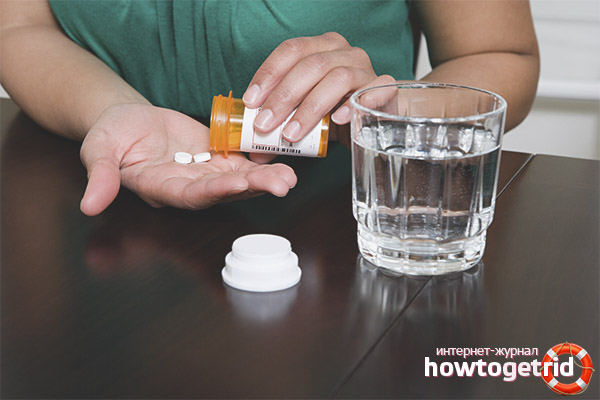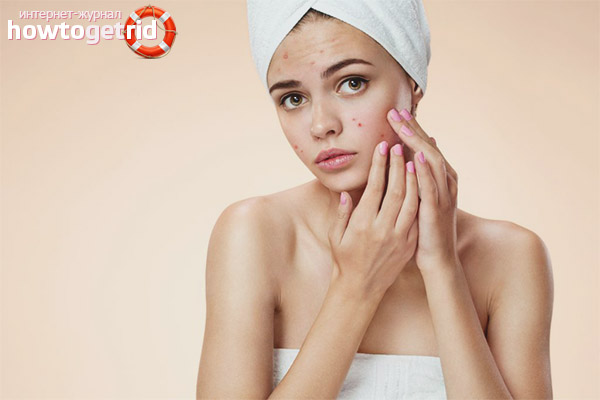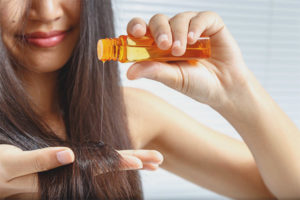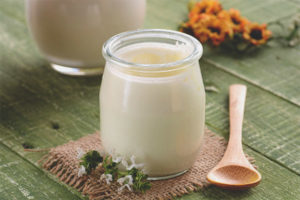The content of the article
- 1 The relationship of hormones with the appearance of acne
- 2 Acne before menstruation
- 3 The appearance of acne during menopause
- 4 The appearance of hormonal acne in the postpartum period
- 5 Treatment
- 6 Nutrition
- 7 Folk remedies
- 8 Skin care
- 9 Additional recommendations
- 10 Video: hormonal acne - causes and symptoms
Hormones strongly affect all physiological processes that occur in the human body. And such a thing as the formation of acne in women is also often directly related to them. It is unlikely that there will be a person who does not have acne jumping up at least once in his life. It is believed that this is normal for adolescents, since it is during puberty that the global restructuring of the hormonal background takes place. But this can happen in adulthood. Hormonal malfunctions can occur for a variety of reasons, the main ones will be discussed below.
The relationship of hormones with the appearance of acne
The most common type of rash is associated with age-related changes in hormone levels, which occurs during the period when the body is actively growing. This happens during puberty in adolescents. During this period, the human body has an increased production of steroid hormones, mainly androgens. It should be noted that, despite the fact that these sex hormones are considered male, their production occurs in the body of both men and women. It is this phenomenon that has a direct relationship with the appearance of hormonal acne in adolescents. In adults, the amount of androgens increases significantly, affecting the course of many physiological processes, in particular, and representing a provoking factor in the formation of acne. How does this influence?
The fact is that steroids affect the course of complex biochemical reactions in the epidermis, as a result of which the level of sebocytes - sebaceous gland cells increases, that is, the amount of produced skin fat increases.
In a normal state, the consistency of sebum (even with skin prone to oily) is liquid. Hormones significantly increase the amount of fat produced, due to which it acquires a dense and sticky consistency. Acne occurs when the ducts of the hair follicles get clogged with this fat. First, microscopic comedones appear on such a site. After which the formation of open and closed comedones from them. This process is dangerous in that the cork that forms from sebum and clogs the ducts not only prevents the release of excess fat, but also prevents the skin from getting rid of other gland products. As a result, pathogenic bacteria multiply rapidly, which lead to inflammation of the skin and the formation of rashes.
The reasons for this phenomenon can be many, the most common of them:
- Heredity. Increased testosterone production and skin prone to a sensitive reaction to this hormone can be inherited. Therefore, a hereditary predisposition belongs to the provoking factors in the formation of skin rashes. In other words, if a woman has one of her parents suffering from hormonal acne, then she probably will also have to face this problem.
- Failures in the process of lipid metabolism. This happens when the amount of all types of fats in the woman’s blood increases: cholesterol, phospholipids, triglycerides, etc. Exceeding the normal level of fat leads to vascular overload, as a result of which blood circulation is disturbed and some diseases arise. In lipid metabolism, disruptions most often occur when hormone levels change.This happens during menopause, or due to the use of hormone-containing drugs: steroid anabolics, retinoids, corticoids, progesterone, and contraceptives.
- Diseases of the adrenal gland, pituitary gland. Failures in the functioning of these organs can lead to the formation of a hormonal rash.
- Stress. It has long been proven that during the stressful and depressive state, male hormones begin to be actively produced in the body, this affects the skin condition of women, as a result of which acne forms on it.
- Gynecological diseases. These include the formation of cysts on the ovaries, hyperandrogenism - a pathological condition in which the female body has an increased production of male hormones, and many other diseases.
Acne before menstruation
In the first half of the menstrual cycle, the estrogen content in the blood of a woman exceeds the amount of progesterone. After ovulation has occurred, their concentration decreases, and now there is more progesterone. At the same time, the testosterone content during the cycle is characterized by stability.
But due to the fact that the “retention” effect of estrogen is reduced before the onset of menstruation, testosterone can adversely affect the skin condition, hormonal acne is formed on the face, shoulders, chest and other parts of the body.
The appearance of acne during menopause
When a woman reaches the age of forty, she can have menopause at any time - the ovarian function gradually fades away, this leads to a decrease in estrogen production. As a result, the prevalence of androgens is observed, the production of which in the female body occurs mainly in the adrenal glands.
Rashes can form even when hormone replacement therapy is used, if it uses more progesterone than estrogen. Therefore, it is better to consult a gynecologist to find the right treatment.
The appearance of hormonal acne in the postpartum period
After childbirth in the female body, an increase in the amount of progesterone is observed, while the level of estrogen is unstable. As a result, sebum begins to be produced intensively and clog pores. Hormonal acne that occurs in the postpartum period, usually formed on the neck and lower half of the face, and does not disappear for a long time. In this case, the use of oral contraceptives will be a more effective option for combating rashes. But only a specialist should deal with their appointment, selecting only those drugs that can be taken during lactation.
Treatment
To get rid of hormonal acne, it is necessary to lower the content of testosterone in the body. To do this, take medications that the doctor will prescribe, as well as follow a diet and properly care for the skin.
Hormonal drugs
For successful treatment of acne, you need to get rid of the provoking factor that caused its appearance. This will require you to go through all the diagnostic procedures that the doctor will prescribe.
Drug therapy is based on the intake of such drugs:

- Oral contraceptives, which include progesterone and estrogen. Such drugs help reduce the production of androgens, so that after three months of taking, the formation of rashes decreases. But it must be borne in mind that when the drug is canceled, acne may occur again and there will be even more than before therapy. It is preferred that drospirenone, norethindrone or norgestimate be present in combination with ethinyl estradiol.
- Metformin. The medicine helps to reduce insulin resistance.
- Antiandrogens.Reduce testosterone production, helping to get rid of acne in three months of use.
- Oral contraceptives should not be used for patients who have an increased blood viscosity, as well as those who suffer from high blood pressure, breast cancer, addiction to cigarettes.
Nutrition
To get rid of hormonal acne, it is recommended to adjust your diet. You should abandon the use of sugar and simple carbohydrates. Limitations of proteins and fats are not required, but it is desirable that the latter are mostly vegetable. In addition, it should be borne in mind that those who often consume dairy products are more prone to acne.
Folk remedies
Of great benefit in the treatment of hormonal acne will bring such plants that reduce the amount of insulin or eliminate the imbalance of sex hormones. These include the following:
- Cinnamon. Although the effectiveness of this product against hormonal rashes has no evidence, it helps some. Be that as it may, adding this spice to food does not harm health, but can reduce the manifestation of acne.
- Mint. It is known that if you drink two cups of tea with mint per day, the production of androgens will decrease, and estrogen, on the contrary, will increase. This will benefit women suffering from hormonal acne.
- Apple vinegar. Helps slow down digestive processes and the absorption of simple carbohydrates, thereby reducing insulin production. Helps patients with rashes due to the presence of cysts on the ovaries. It is taken orally by two large spoons per day.
Skin care
The same care products are used as with other varieties of acne. In addition, preference should be given to drugs, which include the following ingredients:
- tea tree extract;
- Argan oil;
- grape seeds;
- sesame seeds;
- lotus extract;
- rosehip essential oil.
It is recommended not to use products that include coconut and olive oils.
Skin care can be supplemented with acne pharmacy products. One of the most effective of them is Zenerit, which includes erythromycin and zinc compounds. The tool provides drying of the skin, reduces the function of the sebaceous glands, and also prevents the multiplication of pathogenic bacteria on the skin surface that cause the inflammatory process.
Additional recommendations
- Do not sunbathe. In the summer months, use sunscreen with a degree of protection of at least 15.
- Wash your face twice a day with products that contain an antibacterial component, for example, green tea. Soap is not recommended.
- Throughout the day, do not touch your face with unwashed hands.
- Do not try to get rid of acne by squeezing.
- Do not cauterize with iodine, brilliant green, manganese solution, alcohol-containing agents.
The fight against hormonal rashes is a rather difficult task, which requires a lot of effort and time. The most important thing to consider is that you won’t be able to completely get rid of them until the main reason for their appearance has been cured - a hormonal disorder. Therefore, it is impossible to cope with this without consulting a specialist.
Video: hormonal acne - causes and symptoms










Submit